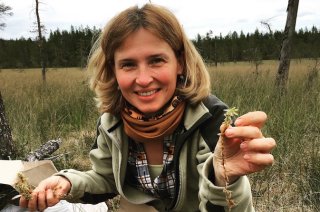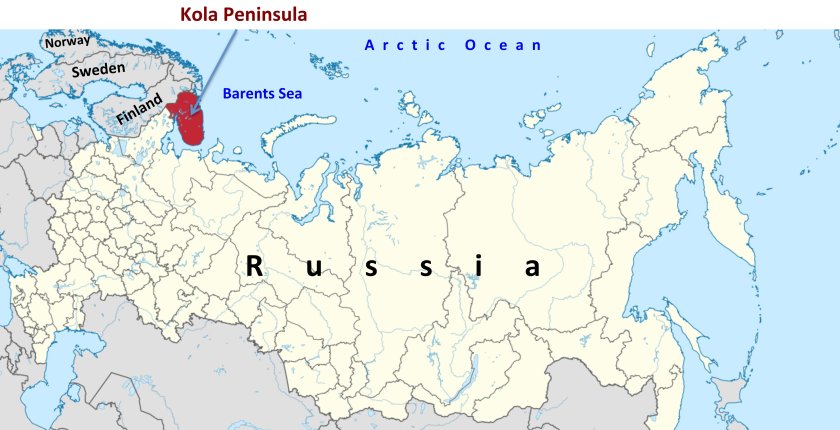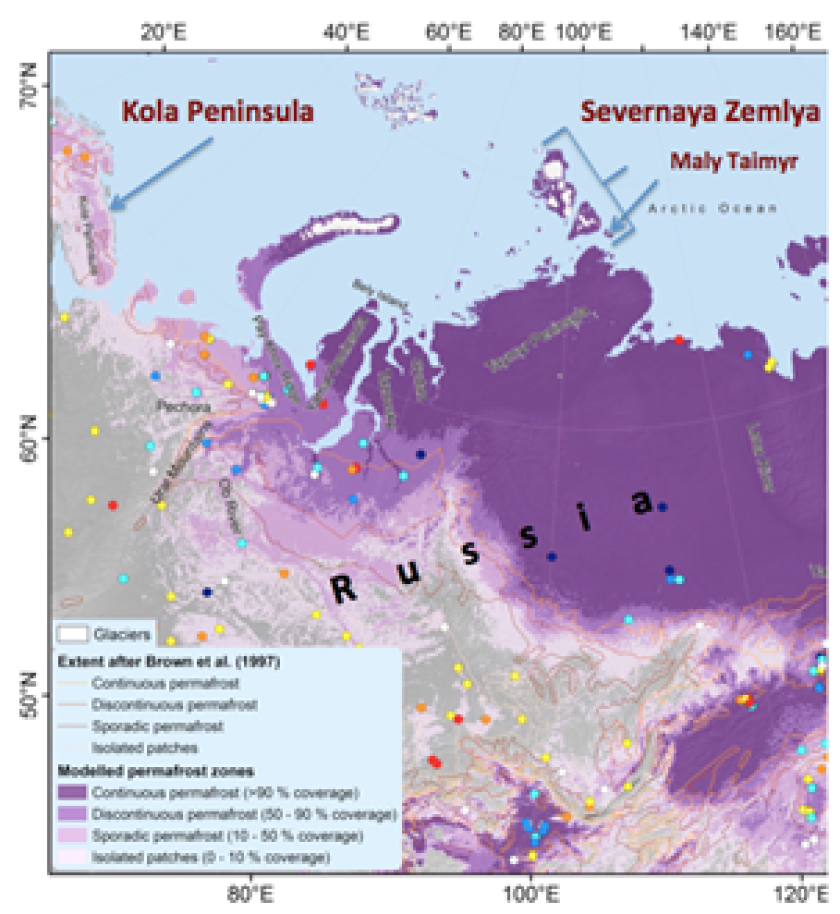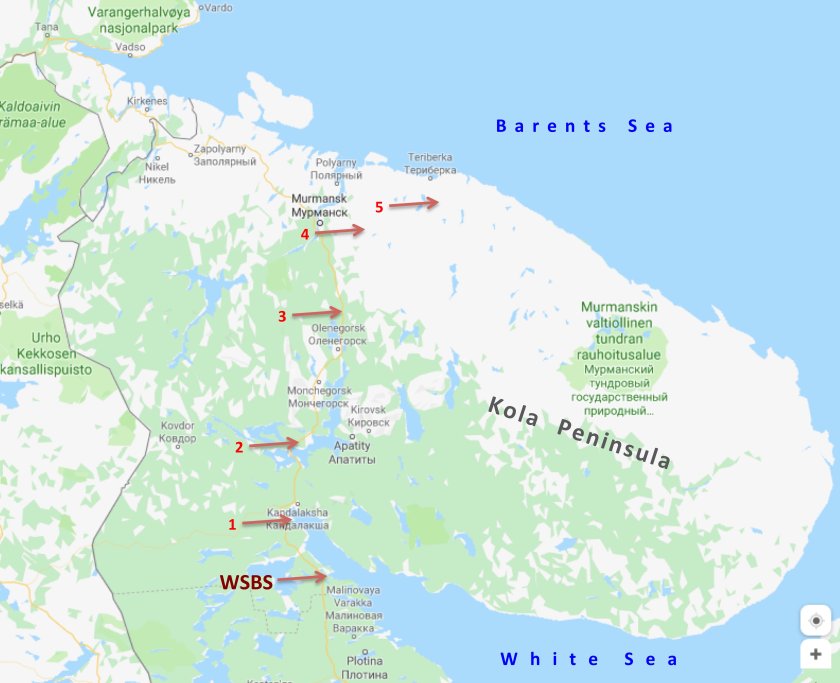
Project
Fungi in boreal peatlands and polar regio
Fungi play a significant role in terrestrial ecosystem functioning as the main decomposers of the organic matter in soils and peatlands. Arctica and Antarctica contain permafrost and extreme conditions for life. A better understanding of the fungal diversity and functional roles in permafrost soils and peatlands is needed to better predict how these ecosystems will respond to climate change. Our interests are focused on studying the biodiversity role of fungi in the polar regions and boreal peatlands.
The role and diversity of fungi in northern peatlands and polar regions is poorly understood. We have results of our investigations of fungi in peatlands located at the White Sea area. Recently, we have expanded the geography of research to the permafrost zone, due to thawing of which the area of peatlands increases, and, as a result, the emission of greenhouse gases increases because of the boost of microbial activity.
Monitoring of fungal communities in the polar regions and boreal peatlands has been recognized as a promising direction of ecological sciense. Based on published scientific data we can make some conclusions:
- scientists do not have an understanding of the full picture of processes occurring in peatlands, including those influenced by climate change;
- investigation of regions with thawing permafrost is recognized by many researches as one of the most important scientific areas today
- the composition and activity of microbial communities affect the rate of greenhouse gases emissions;
- a significant part of the area of thawing permafrost is transformed into peatlands;
- it is known that fungi play a significant role at the first stages of peat formation: they make the plant substrate accessible to bacteria;
- the activity of fungi affects the processes of peat formation and greenhouse gas emissions;
- data on fungi during thawing permafrost is very limited;
- according to the unique species composition of fungi and bacteria in sediments of ponds formed due to permafrost thawing, they seems to be unique ecosystems;
- fungal abundance shows rapid increase just after permafrost thaw when temperature rises above 0°C, which can provoke a strong acceleration of the decomposition of the plant substrate in thawing zones;
- this confirms the assumption that fungi isolated from permafrost habitats function poorly, however they immediately activate when conditions change;
- researchers use molecular and cultural approaches for detection and identification of fungi; both of these methods have their strengths and weaknesses.
We founded just a few works in which both groups of methods were applied, although they complement each other very well. Based on these conclusions I created our research plan.
Research plan
The main study area of our research is the Kola Peninsula (Murmansk region) locatedin the far northwest of Russia(67°41’18”N, 35°56’38”E; Fig. 1).

In previous studies, we showed the specificity offungalcomplexes in the northernregions,andrevealeddegradersof sphagnum mosses and species associated with insects. Wefoundthatdominant speciescould growin a wide range of pH values,andidentified species that can function at low temperatures and in conditions of oxygen deficiency.We propose to study the role of fungi in changingmicrobial biomass dynamicsdue to declining permafrost with global climate change.To obtain objective information andtocreate an adequate picture of the dynamics of thefungalcommunity in the global melting process of perennial and permafrost, we planto expandthe research area to identify common patterns and structural features of the fungal community in peatlands of thenorthern regions.
The Kola Peninsula has areas of periodic and sporadic permafrost (Fig. 2).

Moreover, this region is intensely rising because of glacio-isostatic movement. Consequently, the Kola Peninsula is a unique model object, where the formation of peatlands occurs both due to the rise of land and because of permafrost thawing. Our additional study areas of fungi in permafrost are located in Severnaya Zemlya. These regions are of continuous permafrost (Fig. 3).

We plan to analyze samples from this place by metabarcoding analysis to compare the fungal community from sporadic/temporal permafrost at the Kola Peninsula with that of the region of continuous permafrost.
Study of the fungal diversity of the Kola Peninsula peatlands by molecular (metabarcoding) and culture methods.
Scientific background
In the summer of 2019, we took 90 samples of peat along a transect from south to north approximately every 100 km from five peatlands of the Kola Peninsula. The first sampling point is about 100 km north of the White Sea Biological Station (WSBS) – the place of our previous research (Fig. 4). At the moment we have about 2 thousand colonies of pure fungal cultures which need to be identified (read more methods1) and results of ITS sequencing.

Additional study of the fungal diversity of continuous permafrost areas (Severnaya Zemlya)
In the summer of 2019, 9 soil samples were taken from the bog ecotopes of Maly Taimyr Island (7807’00”N, 10713’00”E; Sea of the Laptev, Severnaya Zemlya) (Fig. 3). For now we have results of ITS sequencing of these samples.
Our tasks:
- to identify available pure culture fungi from Kola Peninsula by morphology and molecular approaches from 2019 sampling and make metabarcoding analysis for 45 samples.
- to analyse metabarcoding analysis for samples of continuous permafrost areas (Severnaya Zemlya) and compare the communities of fungi from different types of permafrost (periodic, sporadic and continuous).
- to compare the results obtained with molecular and cultural methods.
- to expand the collection of fungi from the boreal peatlands including permafrost areas; the resulting species can be used in further experimental studies, including the study of their physiology (growth on media with different pH, temperature and salinity, enzymatic activity); they can also be used as indicator species for quick assessment of biodiversity.
- to study physiology of the dominant fungi from our research: growth on media with different pH, temperature and salinity; with different concentrations of tannin, lignin and cellulose; with low O2 level; it will help us to detect species that are functionally significant in the permafrost conditions.
- to isolate fungi from Sphagnum spp. under different conditions (O2, temperature, humidity) and also test these samples for unculturable fungi growing on Sphagnum; to make to make fungal growth experiment on sphagnum in situ.
- to write a review about fungi in polar regions.
Results
Three articles about fungi in boreal peatlands which will be chapters in my PhD thesis:
- Grum-Grzhimaylo, O.A., Debets, A. J. M., & Bilanenko, E. N. (2016). The diversity of microfungi in peatlands originated from the White Sea. Mycologia, 108(2). DOI
- Bilanenko, E. N., & Grum-Grzhimaylo, O. A. (2016). A comparative analysis of the cultured micromycetes in oligotrophic peatlands of natural biosphere reservations located in the northern and central parts of Russia. Nature Conservation Research, 1(2).
- Grum-Grzhimaylo, Olga A., Debets, A. J. M., & Bilanenko, E. N. (2018). Mosaic structure of the fungal community in the Kislo-Sladkoe Lake that is detaching from the White Sea. Polar Biology, 41(10), 2075–2089. DOI
Other publications
- Grum-Grzhimaylo, O.A., & Bilanenko, E. N. (2010). Microfungi as a component of bogs ecosystems. Mikologiya I Fitopatologiya, 44(6): 485-496 (in Russian)
- Grum-Grzhimaylo, O.A., & Bilanenko, E. N. (2012). The micromycete complexes of Bogs at the Kandalaksha bay of the White sea. Mikologiya I Fitopatologiya, 46(5): 297-305 (in Russian).
- Bubnova, E. N., Grum-Grzhimaylo, O. A., Konovalova, O. P., & Marfenina, O. E. (2014). Fifty years of mycological studies at the White Sea Biological Station of Moscow State University: Challenges, results, and outlook. Moscow University Biological Sciences Bulletin, 69(1) (in Russian). DOI
- Grum-Grzhimaylo, O.A., Debets, A. J. M., & Bilanenko, E. N. (2016). The diversity of microfungi in peatlands originated from the White Sea. Mycologia, 108(2). DOI
- Bilanenko, E. N., & Grum-Grzhimaylo, O. A. (2016). A comparative analysis of the cultured micromycetes in oligotrophic peatlands of natural biosphere reservations located in the northern and central parts of Russia. Nature Conservation Research, 1(2).
- Grum-Grzhimaylo, Olga A., Debets, A. J. M., & Bilanenko, E. N. (2018). Mosaic structure of the fungal community in the Kislo-Sladkoe Lake that is detaching from the White Sea. Polar Biology, 41(10), 2075–2089. DOI
- Bubnova, E. N., Georgieva, M. L., & Grum-Grzhimailo, O. A. (2018). Method for Isolation and Enumeration of Fungi Developing in Marine Sediments. Microbiology (Russian Federation), 87(6), 777–782. DOI
- Grum-Grzhimailo, O. A., Bilanenko E.N., Bubnova, E. N., Georgieva, M. L. (2020). Сurrent Trends in the Exploration of Fungi of Northern Peat Bogs in Connection with Climate Change and the Thawing of Perennial and Permafrost. Vestnik RFFI, 106(2): 101-114 (in Russian). DOI
- Bubnova E.N., Grum-Grzhimailo O.A., Kozlovsky V.V. (2020). Composition and Structure of the Community of Mycelial Fungi in the Bottom Sediments of the White Sea. Moscow University Biological Sciences Bulletin, 75(3): 153-158. DOI